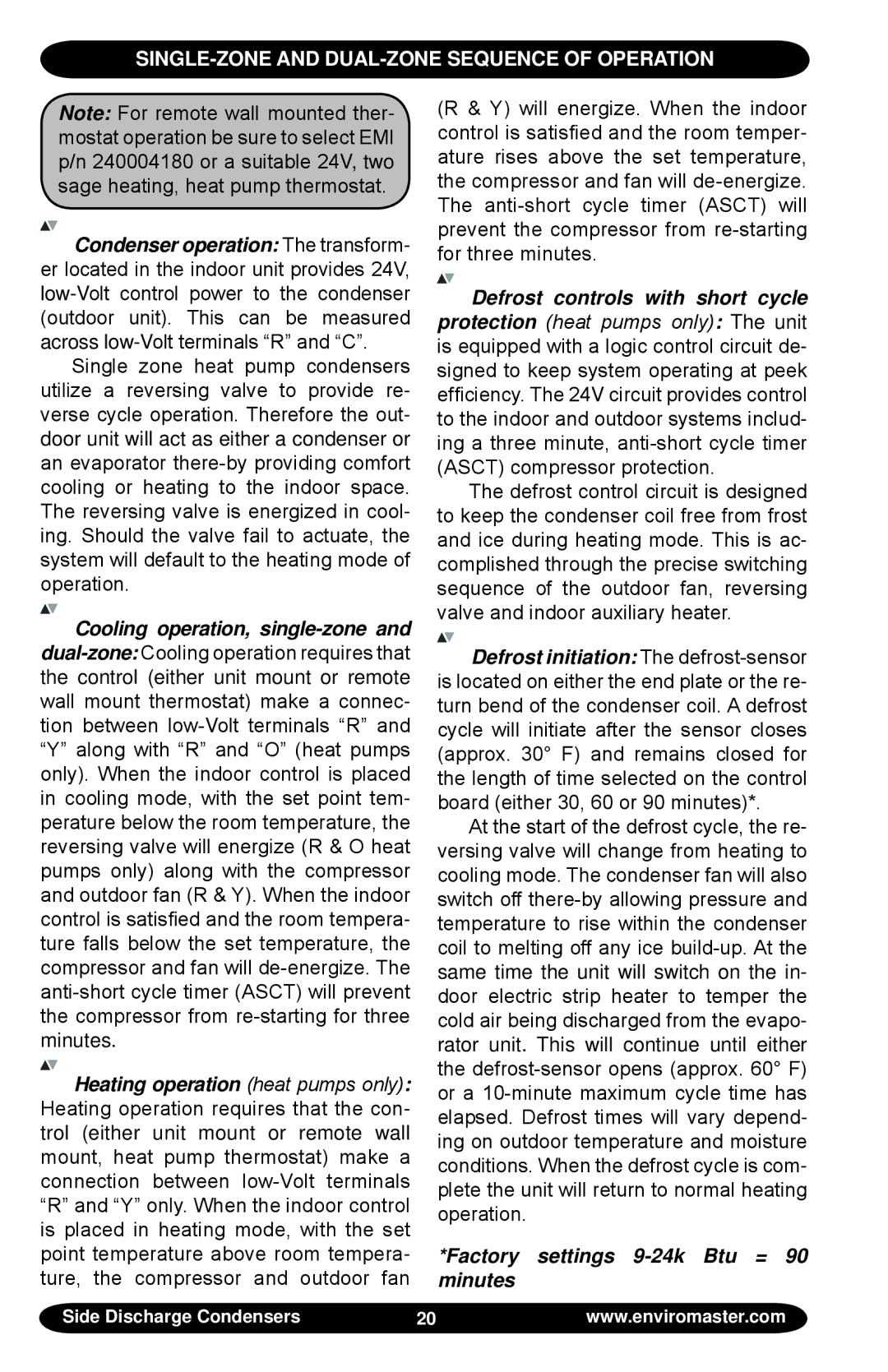Note: For remote wall mounted ther- mostat operation be sure to select EMI p/n 240004180 or a suitable 24v, two sage heating, heat pump thermostat.
Condenser operation: The transform- er located in the indoor unit provides 24V, low-volt control power to the condenser (outdoor unit). This can be measured across low-volt terminals “R” and “C”.
Single zone heat pump condensers utilize a reversing valve to provide re- verse cycle operation. Therefore the out- door unit will act as either a condenser or an evaporator there-by providing comfort cooling or heating to the indoor space. The reversing valve is energized in cool- ing. Should the valve fail to actuate, the system will default to the heating mode of operation.
Cooling operation, single-zone and dual-zone: Cooling operation requires that the control (either unit mount or remote wall mount thermostat) make a connec- tion between low-volt terminals “R” and “Y” along with “R” and “O” (heat pumps only). When the indoor control is placed in cooling mode, with the set point tem- perature below the room temperature, the reversing valve will energize (R & O heat pumps only) along with the compressor and outdoor fan (R & Y). When the indoor control is satisfied and the room tempera- ture falls below the set temperature, the compressor and fan will de-energize. The anti-short cycle timer (ASCT) will prevent the compressor from re-starting for three minutes.
Heating operation (heat pumps only): Heating operation requires that the con- trol (either unit mount or remote wall mount, heat pump thermostat) make a connection between low-Volt terminals “R” and “Y” only. When the indoor control is placed in heating mode, with the set point temperature above room tempera- ture, the compressor and outdoor fan
(R & Y) will energize. When the indoor control is satisfied and the room temper- ature rises above the set temperature, the compressor and fan will de-energize. The anti-short cycle timer (ASCT) will prevent the compressor from re-starting for three minutes.
Defrost controls with short cycle protection (heat pumps only): The unit is equipped with a logic control circuit de- signed to keep system operating at peek efficiency. The 24v circuit provides control to the indoor and outdoor systems includ- ing a three minute, anti-short cycle timer (ASCT) compressor protection.
The defrost control circuit is designed to keep the condenser coil free from frost and ice during heating mode. This is ac- complished through the precise switching sequence of the outdoor fan, reversing valve and indoor auxiliary heater.
Defrost initiation: The defrost-sensor is located on either the end plate or the re- turn bend of the condenser coil. A defrost cycle will initiate after the sensor closes (approx. 30° F) and remains closed for the length of time selected on the control board (either 30, 60 or 90 minutes)*.
At the start of the defrost cycle, the re- versing valve will change from heating to cooling mode. The condenser fan will also switch off there-by allowing pressure and temperature to rise within the condenser coil to melting off any ice build-up. At the same time the unit will switch on the in- door electric strip heater to temper the cold air being discharged from the evapo- rator unit. This will continue until either the defrost-sensor opens (approx. 60° F) or a 10-minute maximum cycle time has elapsed. Defrost times will vary depend- ing on outdoor temperature and moisture conditions. When the defrost cycle is com- plete the unit will return to normal heating operation.
*Factory settings 9-24k Btu = 90 minutesW

